LADEE - on the hunt for moon secrets
Among ufologists, from those who believe in the American landing on the moon, still there are legends about glass towers and castles that astronauts saw there. Despite the fact that the current knowledge of the moon denies the possibility of the presence of fabulous buildings on our natural satellite, the question of what the astronauts observed remained open. To solve it, tomorrow morning, a new NASA mission will launch to the Moon: LADEE Lunar Atmosphere Dust Environment Explorer.

The very name of the device can cause the emotion "Wat?". Yes, Americans are flying to explore the lunar atmosphere. After school truths about the absence of atmosphere there, the goal of the mission looks at least strange. But it is no less strange as the glass locks observed from its surface.

')
As it turned out, the Moon is a rather massive body, so its gravity is capable of supporting a kind of atmosphere. Its more correct name is exosphere.

If the density of the atmosphere of Mars is about 1% of the Earth's atmosphere, then the moon - about 0.001%. On Earth, about 100 billion air molecules are contained in one cubic centimeter, on the Moon - from 100 thousand to 10 million gas molecules. Thus, the density of the atmosphere at the surface of the moon is the approximate density of the earth's atmosphere at the height of the International Space Station. And although, formally, the local conditions can be called a vacuum, in fact the station has to be regularly raised, because it slows down about the atmosphere and gradually decreases.
In addition, dust contributes significantly to the lunar exosphere. Despite the absence of visible meteorological phenomena on the moon, the concentration of dust above the surface may vary. Those. in fact, one can speak of dust storms on the moon. Of course, they cannot be compared with Martian or terrestrial ones, but it is dust, together with exospheric gases, that is responsible for the effect of the observed luminescence above the moon's surface in the predawn hours.

The reasons that raise dust on the moon have yet to be studied, while there are two working hypotheses: meteorite effects and electrification of dust under the action of solar radiation.
These assumptions LADEE must verify during its 100-day mission.
The decision to conduct such studies was made in 2007. Its main principles were low cost: the use of only those devices that do not need to be developed from scratch, and you can take ready-made drawings. The budget of the mission was planned quite modest by nasovskim standards - $ 80 million (in fact it turned out twice as much).
The active phase of construction began in 2012. Thus, NASA built the interplanetary spacecraft in less than two years.
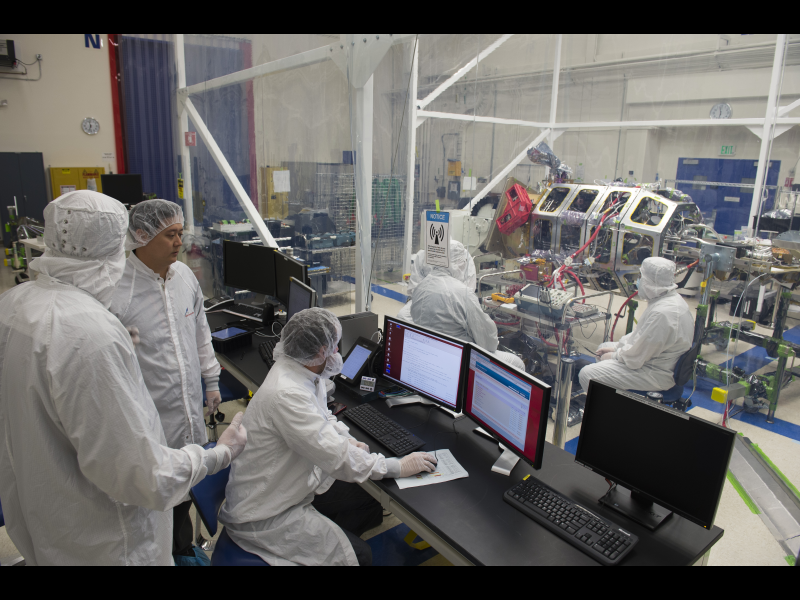
The spacecraft is designed at NASA Ames Research Center is built on a modular scheme that allows you to collect vehicles for various purposes like beads.
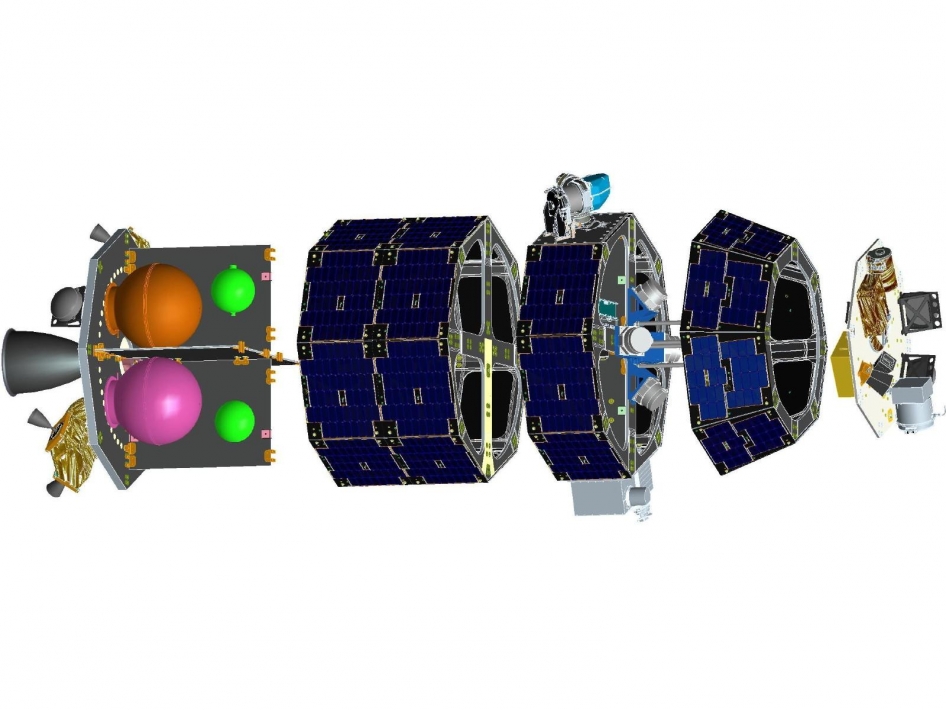
LADEE is not intended for landing, but the developed modular scheme assumes the possibility of creating and landing devices. Such research stations can be sent to the Moon, Mercury or nearby asteroids.

LADEE will be the first experimental modular apparatus that can test the effectiveness of such a design.
Inside the hull is a rocket engine, fuel tanks, and onboard utility systems: control, orientation, power supply, thermoregulation, etc.

Scientific and experimental instruments are located on the outside of the case. Three of them will explore the atmosphere and dust of the Moon, and the fourth device - LLCD (Lunar Laser Communication Demonstration) - will bring the dream of broadband in the Solar System closer and HD video from Mars, Jupiter or Saturn.

The UVS-Ultraviolet-Visible Spectrometer is a small telescope that will observe the glow of the atmospheric limb when a satellite crosses a terminator (the border of the sunlit surface and the shadow side of the surface). An ultraviolet spectrometer will evaluate the emission spectra and determine which substances are present in the atmosphere.
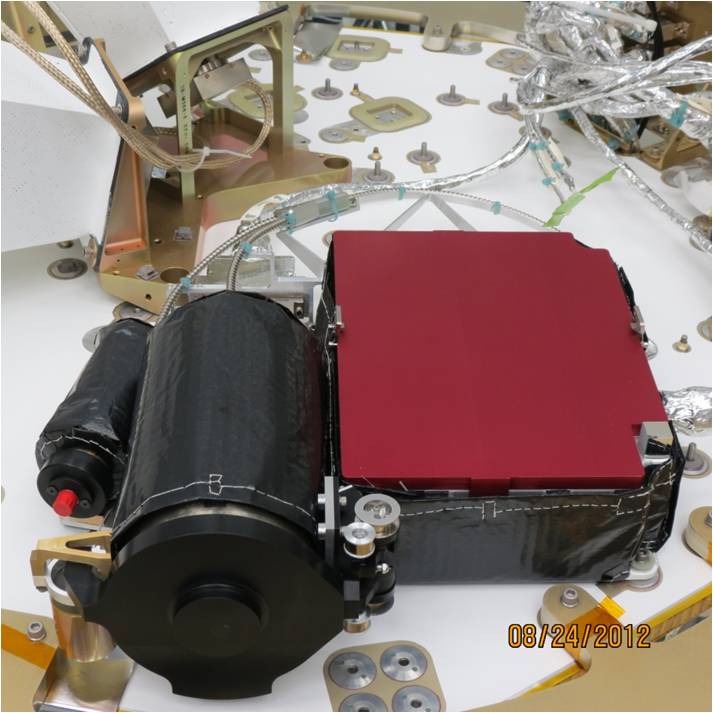

The composition of the lunar atmosphere will be studied by the NMS - Neutral Mass Spectrometer. This is a quadrupole mass spectrometer that can study in detail the composition and mass of molecules and atoms of gases in the atmosphere of our satellite. NMS is borrowed from the Cassini station, which has long and successfully been studying Saturn, Titan and other satellites in the ringed giant system.
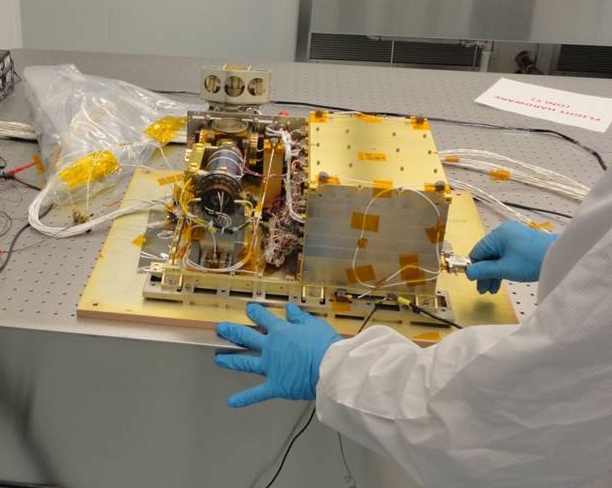
Dust will be studied, too, on the mass of particles, but the device of a different design. The LDEX (Lunar Dust Experiment) is a time-of-flight mass analyzer , and it looks like a car headlight in reverse.

It closes with a lid and has a parabolic trap that will be rotated forward during the flight of the vehicle. When a speck of dust falls into the trap, a microexplosion occurs as a result of the collision due to the flight speed of the LADEE. The ionized particles that arise in it fall on a highly sensitive microchannel plate. The detector registers the velocity of the ions, and calculates their mass from it. Read more about the device.
The LLSD (Lunar Laser Communication Demonstration) experiment should demonstrate the possibility of transmitting information in space over a laser beam. For example, the speed of information transfer from Mars, via radio, from the most modern and powerful satellite that is there - MRO - reaches a speed of 2 Mbit / s. A laser communication device placed on the LADEE should provide speeds of up to 622 Mbit / s.

Communication will be maintained with three receiving stations on Earth:
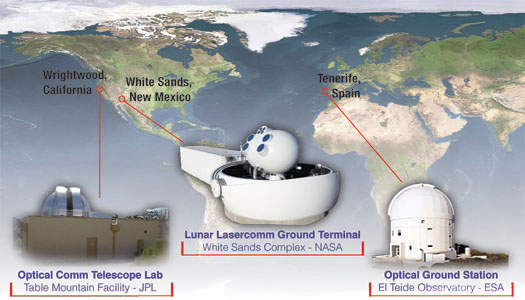
The station in Tenerife in Spain is provided by the European Space Agency under the program of cooperation with NASA.
In addition to the star sensors, there are no cameras on LADEE that could capture the surface of the Moon, i.e. in fact, the device will not be able to create so much information to test the effectiveness of laser transmission. Therefore, most likely, the data will be transmitted first from the Earth to the satellite, and then back. For the transfer of scientific data in the traditional mode, LADEE is equipped with a radio transmitter and an S-band antenna.
The scientific program LADEE assumes work at different altitudes: 250 km and 50 km.
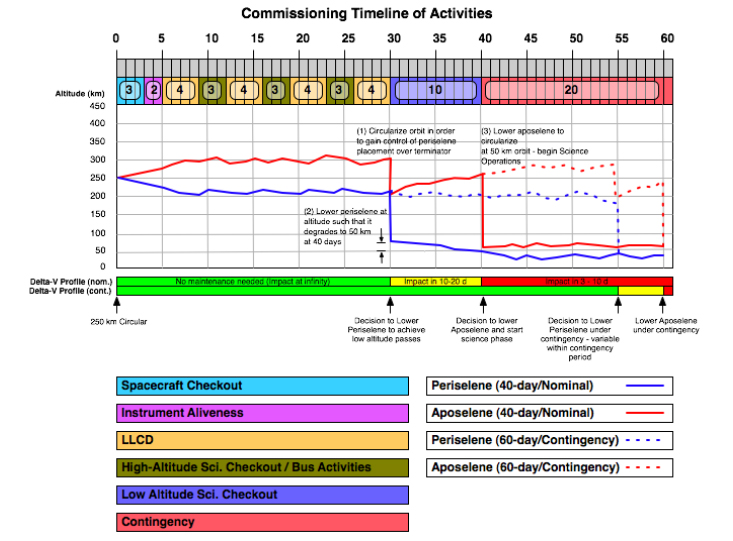
After the main scientific experiments are completed, the device will begin a gradual decline, which will end in a fall. A collision with the surface will be recorded by a high-resolution Lunar Reconnaissance Orbiter camera, just as it was done with GRAIL devices .
NASA scientists hope that during the 100-day scientific program, they will be able to observe the lunar exosphere not only in a static state. The main scientific work will be aimed at determining the dependence of the “weather” state on the influence of the Sun, so the main observations will be made on the lunar terminator.
In addition, scientists hope that they will be able to fix the fall of the meteorite, and fly over this area before the dust from the impact settles. When it was assumed that the Herschel space telescope, after working out its scientific program, would collapse on the moon, LADEE was ready to conduct research on the place of its impact. However, the telescope was sent to the heliocentric orbit, and it remains to hope for good luck.
Therefore, NASA is asking for the help of amateur astronomers and students from around the world who will help notice a meteorite collision. Such collisions are observed quite often, and the coincidence of a suitable LADEE orbit and meteorite impact is only a matter of time and luck.
The tasks assigned to LADEE have very specific practical application. During NASA's manned flights, which lasted only a few days, lunar dust created very significant problems for astronauts.

There are concerns that dust particles having nanometer sizes may be a carcinogenic hazard to humans. Obviously the negative impact of dust on devices and mechanisms. Therefore, humanity should study this problem much better in order to be ready for all the difficulties that the future return to the Moon and its possible colonization can put.
The launch of the Minotaur V rocket from the Wallops cosmodrome will take place on Saturday morning. Will be broadcast on Ustream . LADEE also has its own twitter: NASALADEE
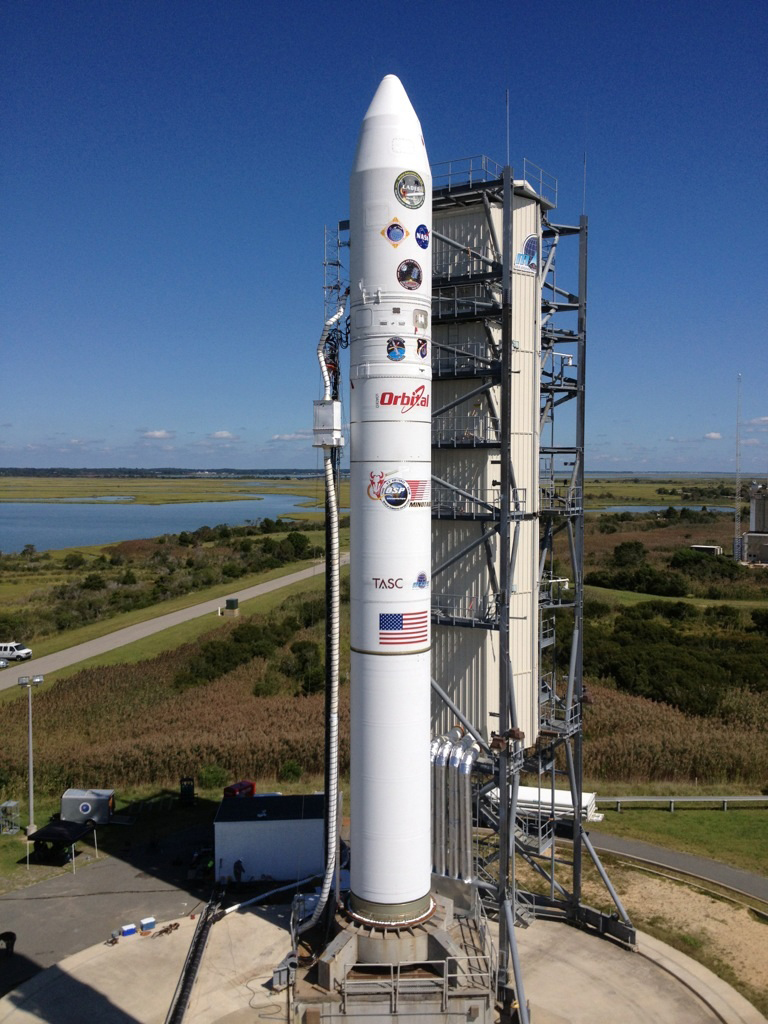

The very name of the device can cause the emotion "Wat?". Yes, Americans are flying to explore the lunar atmosphere. After school truths about the absence of atmosphere there, the goal of the mission looks at least strange. But it is no less strange as the glass locks observed from its surface.

')
As it turned out, the Moon is a rather massive body, so its gravity is capable of supporting a kind of atmosphere. Its more correct name is exosphere.

If the density of the atmosphere of Mars is about 1% of the Earth's atmosphere, then the moon - about 0.001%. On Earth, about 100 billion air molecules are contained in one cubic centimeter, on the Moon - from 100 thousand to 10 million gas molecules. Thus, the density of the atmosphere at the surface of the moon is the approximate density of the earth's atmosphere at the height of the International Space Station. And although, formally, the local conditions can be called a vacuum, in fact the station has to be regularly raised, because it slows down about the atmosphere and gradually decreases.
In addition, dust contributes significantly to the lunar exosphere. Despite the absence of visible meteorological phenomena on the moon, the concentration of dust above the surface may vary. Those. in fact, one can speak of dust storms on the moon. Of course, they cannot be compared with Martian or terrestrial ones, but it is dust, together with exospheric gases, that is responsible for the effect of the observed luminescence above the moon's surface in the predawn hours.

The reasons that raise dust on the moon have yet to be studied, while there are two working hypotheses: meteorite effects and electrification of dust under the action of solar radiation.
These assumptions LADEE must verify during its 100-day mission.
The decision to conduct such studies was made in 2007. Its main principles were low cost: the use of only those devices that do not need to be developed from scratch, and you can take ready-made drawings. The budget of the mission was planned quite modest by nasovskim standards - $ 80 million (in fact it turned out twice as much).
The active phase of construction began in 2012. Thus, NASA built the interplanetary spacecraft in less than two years.

The spacecraft is designed at NASA Ames Research Center is built on a modular scheme that allows you to collect vehicles for various purposes like beads.

LADEE is not intended for landing, but the developed modular scheme assumes the possibility of creating and landing devices. Such research stations can be sent to the Moon, Mercury or nearby asteroids.

LADEE will be the first experimental modular apparatus that can test the effectiveness of such a design.
Inside the hull is a rocket engine, fuel tanks, and onboard utility systems: control, orientation, power supply, thermoregulation, etc.

Scientific and experimental instruments are located on the outside of the case. Three of them will explore the atmosphere and dust of the Moon, and the fourth device - LLCD (Lunar Laser Communication Demonstration) - will bring the dream of broadband in the Solar System closer and HD video from Mars, Jupiter or Saturn.

The UVS-Ultraviolet-Visible Spectrometer is a small telescope that will observe the glow of the atmospheric limb when a satellite crosses a terminator (the border of the sunlit surface and the shadow side of the surface). An ultraviolet spectrometer will evaluate the emission spectra and determine which substances are present in the atmosphere.


The composition of the lunar atmosphere will be studied by the NMS - Neutral Mass Spectrometer. This is a quadrupole mass spectrometer that can study in detail the composition and mass of molecules and atoms of gases in the atmosphere of our satellite. NMS is borrowed from the Cassini station, which has long and successfully been studying Saturn, Titan and other satellites in the ringed giant system.

Dust will be studied, too, on the mass of particles, but the device of a different design. The LDEX (Lunar Dust Experiment) is a time-of-flight mass analyzer , and it looks like a car headlight in reverse.

It closes with a lid and has a parabolic trap that will be rotated forward during the flight of the vehicle. When a speck of dust falls into the trap, a microexplosion occurs as a result of the collision due to the flight speed of the LADEE. The ionized particles that arise in it fall on a highly sensitive microchannel plate. The detector registers the velocity of the ions, and calculates their mass from it. Read more about the device.
The LLSD (Lunar Laser Communication Demonstration) experiment should demonstrate the possibility of transmitting information in space over a laser beam. For example, the speed of information transfer from Mars, via radio, from the most modern and powerful satellite that is there - MRO - reaches a speed of 2 Mbit / s. A laser communication device placed on the LADEE should provide speeds of up to 622 Mbit / s.

Communication will be maintained with three receiving stations on Earth:

The station in Tenerife in Spain is provided by the European Space Agency under the program of cooperation with NASA.
In addition to the star sensors, there are no cameras on LADEE that could capture the surface of the Moon, i.e. in fact, the device will not be able to create so much information to test the effectiveness of laser transmission. Therefore, most likely, the data will be transmitted first from the Earth to the satellite, and then back. For the transfer of scientific data in the traditional mode, LADEE is equipped with a radio transmitter and an S-band antenna.
The scientific program LADEE assumes work at different altitudes: 250 km and 50 km.

After the main scientific experiments are completed, the device will begin a gradual decline, which will end in a fall. A collision with the surface will be recorded by a high-resolution Lunar Reconnaissance Orbiter camera, just as it was done with GRAIL devices .
NASA scientists hope that during the 100-day scientific program, they will be able to observe the lunar exosphere not only in a static state. The main scientific work will be aimed at determining the dependence of the “weather” state on the influence of the Sun, so the main observations will be made on the lunar terminator.
In addition, scientists hope that they will be able to fix the fall of the meteorite, and fly over this area before the dust from the impact settles. When it was assumed that the Herschel space telescope, after working out its scientific program, would collapse on the moon, LADEE was ready to conduct research on the place of its impact. However, the telescope was sent to the heliocentric orbit, and it remains to hope for good luck.
Therefore, NASA is asking for the help of amateur astronomers and students from around the world who will help notice a meteorite collision. Such collisions are observed quite often, and the coincidence of a suitable LADEE orbit and meteorite impact is only a matter of time and luck.
The tasks assigned to LADEE have very specific practical application. During NASA's manned flights, which lasted only a few days, lunar dust created very significant problems for astronauts.

There are concerns that dust particles having nanometer sizes may be a carcinogenic hazard to humans. Obviously the negative impact of dust on devices and mechanisms. Therefore, humanity should study this problem much better in order to be ready for all the difficulties that the future return to the Moon and its possible colonization can put.
The launch of the Minotaur V rocket from the Wallops cosmodrome will take place on Saturday morning. Will be broadcast on Ustream . LADEE also has its own twitter: NASALADEE

Source: https://habr.com/ru/post/192776/
All Articles